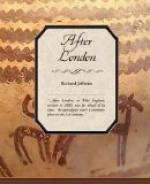Hawthorn bushes sprang up among them, and, protected by the briars and thorns from grazing animals, the suckers of elm-trees rose and flourished. Sapling ashes, oaks, sycamores, and horse-chestnuts, lifted their heads. Of old time the cattle would have eaten off the seed leaves with the grass so soon as they were out of the ground, but now most of the acorns that were dropped by birds, and the keys that were wafted by the wind, twirling as they floated, took root and grew into trees. By this time the brambles and briars had choked up and blocked the former roads, which were as impassable as the fields.
No fields, indeed, remained, for where the ground was dry, the thorns, briars, brambles, and saplings already mentioned filled the space, and these thickets and the young trees had converted most part of the country into an immense forest. Where the ground was naturally moist, and the drains had become choked with willow roots, which, when confined in tubes, grow into a mass like the brush of a fox, sedges and flags and rushes covered it. Thorn bushes were there, too, but not so tall; they were hung with lichen. Besides the flags and reeds, vast quantities of the tallest cow-parsnips or “gicks” rose five or six feet high, and the willow herb with its stout stem, almost as woody as a shrub, filled every approach.
By the thirtieth year there was not one single open place, the hills only excepted, where a man could walk, unless he followed the tracks of wild creatures or cut himself a path. The ditches, of course, had long since become full of leaves and dead branches, so that the water which should have run off down them stagnated, and presently spread out into the hollow places and by the corner of what had once been fields, forming marshes where the horsetails, flags, and sedges hid the water.
As no care was taken with the brooks, the hatches upon them gradually rotted, and the force of the winter rains carried away the weak timbers, flooding the lower grounds, which became swamps of larger size. The dams, too, were drilled by water-rats, and the streams percolating through, slowly increased the size of these tunnels till the structure burst, and the current swept on and added to the floods below. Mill-dams stood longer, but, as the ponds silted up, the current flowed round and even through the mill-houses, which, going by degrees to ruin, were in some cases undermined till they fell.
Everywhere the lower lands adjacent to the streams had become marshes, some of them extending for miles in a winding line, and occasionally spreading out to a mile in breadth. This was particularly the case where brooks and streams of some volume joined the rivers, which were also blocked and obstructed in their turn, and the two, overflowing, covered the country around; for the rivers brought down trees and branches, timbers floated from the shore, and all kinds of similar materials, which grounded in the shallows or caught against snags, and formed huge piles where there had been weirs.




